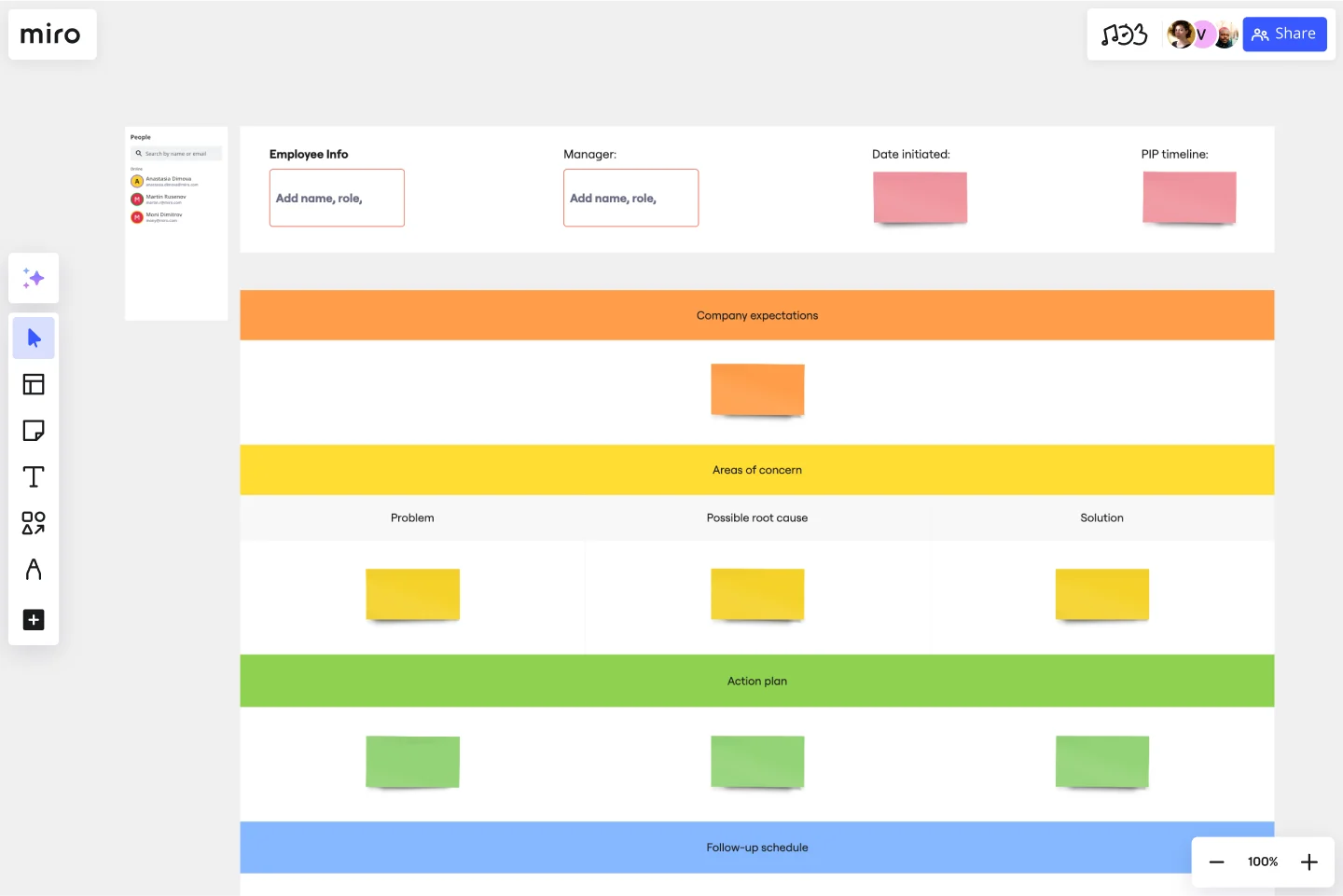Performance Improvement Plan Template
The Performance Improvement Plan Template is a structured tool for addressing employee performance and promoting actionable and clear feedback. Use it to align expectations and have better career conversations.
About the Performance Improvement Plan Template
A Performance Improvement Plan Template is a practical tool that enables teams and managers to collaboratively address and enhance performance issues. This template aims to ensure better outcomes and a cohesive working environment by streamlining communication and providing a clear roadmap for improvement.
What's a Performance Improvement Plan Template?
Managers and HR professionals use a Performance Improvement Plan (PIP) Template to address and monitor underperformance or behavioral issues in an employee. It facilitates open communication, clearly defines expectations, and offers a roadmap for improvement. Three benefits of using a PIP Template are:
Structured communication: Instead of vague feedback, the template ensures that feedback is structured, specific, and actionable.
Clarity and accountability: It clearly outlines expectations and steps for improvement, ensuring the manager and employee understand what's needed.
Documentation: Provides a written record of performance discussions, which can be crucial for HR processes.
How to use a Performance Improvement Plan Template in Miro?
Using the template in Miro is straightforward. Let's go over each field:
Employee info: Capture the basic details such as name, role, and department. It's the starting point to ensure clarity about whose performance is under consideration.
Company expectations: Detail what is expected of the employee regarding role requirements, behavior, and performance metrics.
Areas of concern: This section has three subfields: Problem: Clearly state the performance or behavior issue. Possible root cause: This is a space for managers to hypothesize or note reasons behind the concern, fostering a holistic understanding. Solution: Propose ways or strategies to address the problem.
Action plan: Lay out steps the employee should take to improve. This could be trainings, mentorship, or other resources.
Follow-up schedule: Schedule check-ins to monitor progress, discuss challenges, and provide feedback.
Consequences of inaction: Describe potential outcomes if no improvement is seen. This helps in reinforcing the importance of the PIP.
Remember, a Performance Plan is not just about pointing out issues but paving a way forward for employees to succeed. With Miro's PIP Template, that journey becomes a collaborative and structured process.
Is the Performance Improvement Plan a disciplinary action?
No, a PIP is primarily a tool to guide and support employees toward better performance. While it can be a step before disciplinary actions, its main goal is to provide clear expectations and resources for improvement.
How long should a typical PIP last?
The duration can vary based on the nature of the issues and the company's policies, but typically, it lasts between 30 to 90 days.
What if the employee doesn't agree with the content of the PIP?
It's essential for the manager and employee to have open communication. If there are disagreements, they should be discussed, and if necessary, HR can mediate to ensure fairness and clarity.
Can the PIP template be customized in Miro?
Yes, the template is designed to be flexible, and users can customize it to fit their organization's unique needs and processes.
Get started with this template right now.
To-do List Template
Works best for:
Project Management, Education, Decision Making
A to-do list helps teams manage, organize, and prioritize their upcoming tasks. As a result, they can improve time management and streamline work operations. Using Miro’s to-do list template, teams create interactive, collaborative, and user-friendly task lists.
Rose, Bud, Thorn Retrospective Template
Works best for:
Agile Workflows, Retrospectives
Run a simple yet effective retrospective with the Rose, Bud, Thorn Retrospective Template. Identify positive outcomes, challenges, and opportunities moving forward.
Johari Window Model
Works best for:
Leadership, Meetings, Retrospectives
Understanding — it’s the key to trusting others better and yourself better as well. Built on that idea, a Johari Window is a framework designed to enhance team understanding by getting participants to fill in four quadrants, each of which reveals something they might not know about themselves or about others. Use this template to conduct a Johari Window exercise when you’re experiencing organizational growth, to deepen cross-functional or intra-team connections, help employees communicate better, and cultivate empathy.
Cross Functional Flowchart
Works best for:
Org Charts, Business Management
Have a quick look at everyone on a project and see exactly what they’ll contribute. That’s the clarity and transparency a cross-functional flowchart will give you. These are also called “swim lane” flowcharts because each person (each customer, client, or representative from a specific function) is assigned a lane—a clear line—that will help you visualize their roles at each stage of the project. This template will empower you to streamline processes, reduce inefficiencies, and make meaningful cross-functional relationships.
Manual of Me Template
Works best for:
Organizational Design
The Manual of Me template helps express personal and professional characteristics. It promotes better communication and reduces misunderstandings. This enhances productivity and fosters a more harmonious environment. The template acts as a bridge for understanding unique approaches and facilitates respectful collaboration.
Social Media Calendar Template
Works best for:
Project Planning, Marketing
Most businesses have a social media presence, but many of them aren’t using social media as a competitive differentiator. The Social Media Calendar template allows you to plan, schedule, and craft posts for LinkedIn, Twitter, Facebook, Instagram, and Pinterest, so you can leverage social media as a strategic tool to promote your brand. Use the Social Media Calendar template to plan out your social content a week, month, or quarter in advance. Collaborate with the marketing team, prepare for product launches and major initiatives, and share draft social posts.
